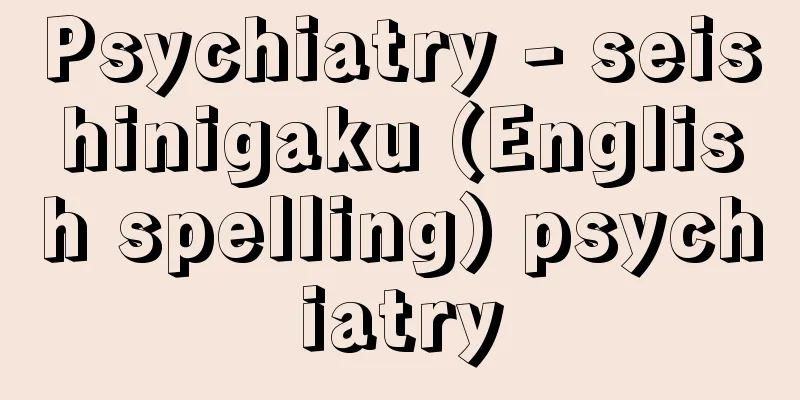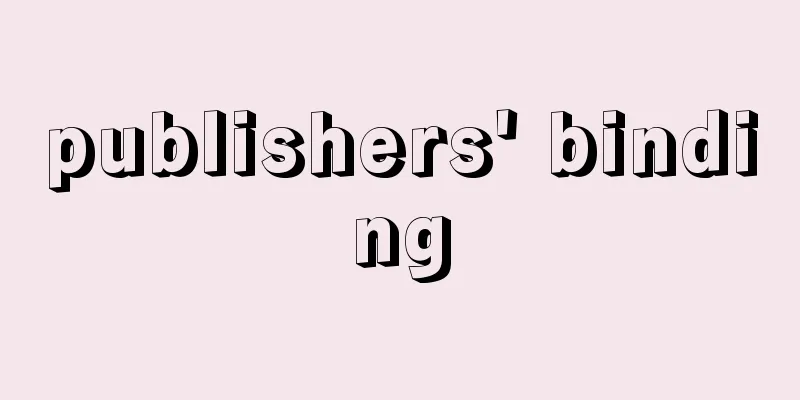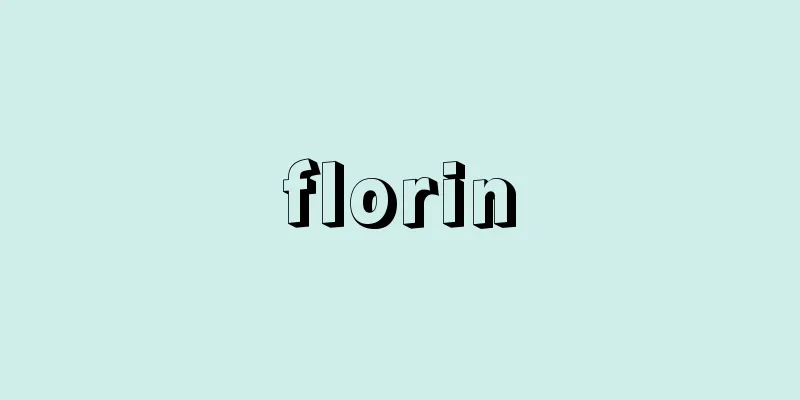Psychiatry - seishinigaku (English spelling) psychiatry

|
Psychiatry is a branch of medicine that deals with the prevention, diagnosis, and treatment of mental problems and mental illnesses. The term "psychiatry" was first used by the German physician Reil, JC in 1808. Initially, it meant "therapy by mental stimulation" for all illnesses, including not only mental illnesses but also physical illnesses. From the early 1800s, definitions and treatments for mental illnesses were established in various countries, and at the same time, scientific verification of mental illnesses was carried out, and by the end of the 1800s, the concept of psychiatry was established. [Classification of psychiatry] Psychiatry involves various disciplines, classified from three aspects: bio-psycho-social. First, the field that considers and examines the mind from the perspective of brain function is called "biological psychiatry." This includes psychophysiology, neurochemistry, molecular biology, molecular genetics, cognitive psychology, psychopharmacology, and neuropsychology. Next, "psycho" disciplines that attempt to understand the workings of the human mind through philosophy and psychology include psychopathology or descriptive psychiatry, psychoanalysis or dynamic psychiatry, and psychotherapy. Finally, "social" disciplines include social psychiatry, forensic psychiatry, and comparative cultural psychiatry. In addition to these three classifications, there are various other categories of academic fields related to the "mental" such as child psychiatry, geriatric psychiatry, which targets children; geriatric psychiatry, which targets the elderly; liaison psychiatry, which treats psychiatric problems within physical medicine; and mental health studies, which aim to maintain and improve mental health. Each of these fields is closely related and is progressing with the goal of promoting mental maturity in healthy people, preventing and providing early support for mental illness, and treating mental illness. [Psychiatric diagnostics] Mental illnesses were traditionally classified into three categories: exogenous, endogenous, and psychogenic. Organic psychoses, symptomatic psychoses, and toxic psychoses, which are caused by some kind of effect on the brain, were classified as exogenous. Neuroses and adjustment disorders caused by personality or stress in the external environment were also classified as psychogenic. Schizophrenia and manic depression, which are neither exogenous nor psychogenic and have no clear cause, were classified as endogenous. Traditional diagnoses based on such rough classifications are still often used today and are considered useful for determining the characteristics of mental illness throughout a patient's life. They are also an important concept when providing treatment from a long-term perspective. However, it has been found that the reliability and validity of actual diagnoses are inevitably low, and it has become clear that traditional diagnoses alone cannot accurately evaluate all psychiatrists in the same way. For this reason, operational diagnostic criteria have been established, such as "a diagnosis can be made if three or more of the following five symptoms are met." Currently, two operational diagnostic criteria are used: the Diagnostic and Statistical Manual of Mental Disorders (DSM) established by the American Psychiatric Association (APA) and the International Classification of Diseases (ICD) established by the World Health Organization (WHO). Each is revised every few years. The fourth edition of the DSM was published in 2000 as the revised version (DSM-IV-TR), and was revised as the DSM-V in 2013. The ICD was published in 1990, and was further revised in 2007 as the tenth edition (ICD-10). The classification of mental disorders in the ICD and DSM differs in some places, but the differences have become smaller with each revision. Both can be used in clinical settings, but the DSM is used for research purposes, and the ICD is used for official statistics in the mental health field. In addition, structured interviews have been established based on these operational diagnostic criteria, allowing non-psychiatrists to make a final diagnosis by asking questions according to the manual and compiling the answers. These structured interviews are often conducted mainly for research purposes. So how is a diagnosis made in an actual clinical setting? The diagnosis obtained using operational diagnostic criteria only captures one aspect of the patient. A clinical diagnosis takes into account various factors such as the severity of the condition, changes in symptoms throughout a patient's life, social background, and the direction of treatment, and is ultimately useful for formulating a treatment plan. In an actual clinical setting, the job of a psychiatrist is to comprehensively evaluate the characteristics of each patient, including the diagnosis. [Psychiatric Therapeutics] Various methods have been used to treat mental illnesses since ancient times, including continuous sleep therapy, fever therapy, and insulin shock therapy, which were historically performed through trial and error, but these are no longer used today. One treatment that is still used today is electroconvulsive therapy. This treatment was performed based on the experience that inducing convulsions alleviates mental symptoms. Currently, with the cooperation of anesthesiologists, modified electroconvulsive therapy is performed in which an electric current is applied to the head to generate seizure waves in the brain under general anesthesia while muscle relaxants are used to suppress the occurrence of convulsions. It is used for emotional disorders, etc., because it is very effective and safe. The use of drugs for mental illness began in the 1950s, and drug therapy has developed dramatically since then. Currently, drug therapy is indispensable in psychiatric clinical practice, and various types of drugs are used for various symptoms. Not only does it improve symptoms, but it can also prevent the recurrence of symptoms, so it is essential for doctors to become familiar with drug therapy. Psychotherapy is said to be able to further improve the therapeutic effect when used in combination with drug therapy. There are various techniques such as psychoeducation, supportive psychotherapy, cognitive behavioral therapy, social skills training, autogenic training, and family therapy, and these are often combined depending on the illness. Psychoanalytic therapy is also included, but when actually used as a treatment, training of the therapist and selection of the target illness are essential, so it is not frequently used as a treatment method. Rather, knowing psychoanalytic concepts can be helpful in understanding the patient's condition. →Autogenic training →Psychotherapy →Psychoanalysis →Psychoanalytic therapy →Schizophrenia →Cognitive behavioral therapy [Araki Tsuyoshi] Latest Sources Psychology Encyclopedia Latest Psychology Encyclopedia About Information |
|
精神医学とは,こころの問題や精神疾患の予防・診断・治療にかかわる医学の一分野である。1808年ドイツの医学者ライルReil,J.C.が初めてPsychiatrieという用語を用いた。当初は,精神疾患のみならず身体疾患も含めたあらゆる病気に対する「精神的な働きかけによる治療法」を意味していた。その後,1800年代前半より精神疾患の定義や治療が各国で行なわれると同時に精神疾患の科学的検証が行なわれ,1800年代終わりに,精神医学の概念が確立された。 【精神医学の分類】 精神医学の中には生物-心理-社会bio-psycho-socialという三つの側面から分類すると,さまざまな学問が関係している。まず,精神を脳機能から考えて検証を行なう分野は「biological psychiatry」すなわち生物学的精神医学とよばれる。これらの中には精神生理学,神経化学,分子生物学,分子遺伝学,認知心理学,精神薬理学,神経心理学などが含まれる。次に,人のこころの動きを哲学や心理学などを通して理解しようとする「psycho」な学問には精神病理学もしくは記述精神医学,精神分析学もしくは力動精神医学,精神療法学などが含まれる。最後に,「social」な学問には,社会精神医学,司法精神医学,比較文化精神医学などが含まれる。このような3分類の他に,児童を対象とした児童精神医学,老年期を対象とした老年精神医学,身体科医療の中における精神医学的問題を治療していくリエゾン精神医学,精神的健康の保持と向上を目的とする精神保健学など,さまざまなカテゴリーに「精神」に関連する学問があり,それぞれの学問が,健常者のこころの成熟の促進,精神疾患の予防・早期支援,精神疾患の治療を目標として,密接に関連をもって進んでいる。 【精神科診断学】 精神疾患は従来は外因性,内因性,心因性の三つに分類されていた。脳になんらかの影響を及ぼすことによって生じる脳器質性精神病や症状精神病や中毒性精神病などは外因性に分類された。また性格や外的環境のストレスなどから生じる神経症や適応障害などを心因性と分類していた。そして外因性でも心因性でもなく,明確な原因が想定できない疾患である統合失調症や躁うつ病などが内因性と分類されていた。このような大まかな分類に基づく従来診断は現在でも使われることが多く,一人の患者の一生を通して精神疾患の特徴を意味づけるときには有用であるとされる。また長期的な観点から見た治療を行なう際にも重視される概念である。しかし,実際の診断にあたっての信頼性や妥当性がどうしても低くなることが見られており,従来診断のみでは正確にあらゆる精神科医があらゆる患者を同様に評価できないことがわかってきた。そのために,たとえば「以下の五つの症状のうち三つ以上を満たせば診断がつく」というような操作的診断基準が設定されるようになった。現在,アメリカ精神医学会(APA)が定めた『精神障害の診断と統計の手引き(DSM)』と世界保健機関(WHO)が定めた『国際疾病分類(ICD)』との二つの操作的診断基準が使用されている。それぞれ,数年おきに改訂がなされており,DSMは2000年発表の第4版の修正版(DSM-IV-TR)が,2013年にDSM-Vとして改訂された。ICDは1990年に発表され,2007年にはその第10版(ICD-10)のさらなる改訂が行なわれている。ICDとDSMの精神疾患の分類はところどころ異なるところもあるが,改訂を重ねるにつれて,その差異は少なくなってきている。両者ともに臨床場面で使用可能であるが,さらにDSMは研究用に用いられ,ICDは精神保健分野の公式統計に用いられている。また,これらの操作的診断基準に基づいて,精神科医以外でもマニュアルどおりに質問をして回答をまとめていけば最終的な診断が可能となる構造化面接も設定されている。この構造化面接は主として研究用に行なわれることが多い。では実際の臨床の場面ではどのように診断が行なわれるかというと,あくまで操作的診断基準によって得られた診断名は患者の一側面をとらえただけにすぎない。重症度や一生を通しての症状の変化,社会的背景,治療の方向性などさまざまな要因を組み入れて,最終的に治療方針の立案に役立つのが臨床診断となる。実際の臨床場面では個々の患者の特徴を診断名も含めて,包括的に評価していくことが精神科医としての仕事となる。 【精神科治療学】 精神疾患の治療方法としては,昔からさまざまな方法が用いられてきており,持続睡眠療法や発熱療法やインシュリンショック療法など,試行錯誤して行なわれていた歴史的な治療法もあったが,現在はこれらが行なわれることはない。現在でも引き続き行なわれている治療法の一つに電気けいれん療法がある。これは,けいれんを誘発することによって精神症状が軽快するという経験から行なわれた治療である。現在では,麻酔科医の協力も得て,全身麻酔下で筋弛緩薬を用いてけいれんの発生を抑えた状況で,頭部へ通電を行ない,発作波を脳に生じさせる修正型電気けいれん療法が行なわれている。治療効果が非常に高く,安全であるため,感情障害などに対して使用されている。1950年代より精神疾患に対する薬物の使用が開始され,その後,薬物療法が劇的に発展した。現在では薬物療法は精神科臨床において不可欠であり,さまざまな症状に対してさまざまな種類の薬が用いられている。症状を改善するだけでなく,症状の再発予防も可能な側面があり,医師にとって薬物療法の習熟が不可欠となる。薬物療法と併用することによって,さらなる治療効果を上げることができるとされているのが心理療法である。心理教育,支持的精神療法,認知行動療法,社会生活技能訓練,自律訓練法,家族療法などさまざまな手法があるが,疾患に応じてこれらを組み合わせて行なうことが多い。精神分析療法なども含まれるが,実際に治療として行なう場合には治療者の訓練や対象疾患の選別が欠かせず,治療方法としては頻繁に用いられない。むしろ,精神分析学的な概念を知ることは患者の病態の理解において助けとなることはある。 →自律訓練法 →心理療法 →精神分析 →精神分析療法 →統合失調症 →認知行動療法 〔荒木 剛〕 出典 最新 心理学事典最新 心理学事典について 情報 |
<<: Mental Illness - Seishin Ijyou
Recommend
Anato-so - Anou-no-sho
A manor of the Konoe family located in Shiga Count...
Joseph Louis Gay-Lussac
1778‐1850 French physicist and chemist. Born in Li...
Acanthocephala
…A general term for invertebrates belonging to th...
Nonviolent Resistance - Let's go
Resisting authority through nonviolent means. On D...
Name of the person who brought the offering - Kugoninkyomyo
… As an alternative to this, the official lay acc...
Niiname-sai Festival
〘Noun〙 A festival where the Emperor offers new ric...
Tailcoat - Enbifuku
The first formal attire worn by men for evening p...
Francisco de Rojas Zorrilla
1607‐48 Spanish playwright. One of Calderón's ...
Poison fishing
…Similarly, the reading of the character for fish...
Oprichnina (English spelling)
The Special Imperial Territory was created by Russ...
Linaceae - Amaka
Dicotyledonous, polypetalous. Herbaceous or shrub...
Street - Color
〘noun〙① A road in a city. A road in a town. ※Shoku...
jester
…The word fool originates from the Latin follis (...
Mechanical alternans
…This refers to the phenomenon in which the arter...
Carlson, OB - Carlson
…An explosive whose main ingredient is ammonium p...





![Okuwa [village] - Ookuwa](/upload/images/67cb14fbafa0c.webp)
![Parästhesie (English spelling) [Germany]](/upload/images/67cc93250fb01.webp)


